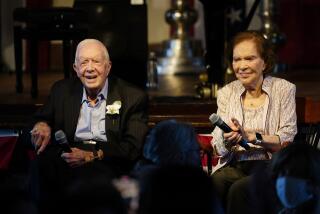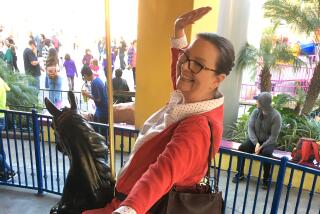Season of Cheer Is Bittersweet for Those Near Death
The Christmas party began festively enough in the west wing of Granada Hills Community Hospital.
Santa Claus dispensed baskets of fruit. Clowns danced through balloon-lined corridors. Family members and friends surrounded the dozen patients well enough to attend the Saturday afternoon event.
But holiday celebration is intertwined with despair in a ward where terminally ill patients confront death.
A 64-year-old patient’s mood turned when carolers sang, “I’ll be Home for Christmas.” The man, who has liver cancer and is paralyzed on his left side after suffering two strokes, is aware that won’t be the case, his wife said.
“He squeezed my hand and broke down when he heard the song,” she said.
Only the most gravely ill patients are admitted to the west wing, which the hospital calls a “symptom-control unit.”
Federal Funding Reduced
The ward was termed a “hospice” when it opened in 1979, accommodating any patient diagnosed with a fatal illness. But federal funding cuts in 1983 forced the hospital to pare down the scope of the ward’s services. It now receives only patients in the final stages of fatal diseases, ward coordinator Diana Sperling said.
“A hospice is a concept that allows for the patient and the family to at least be comfortable for the period of time that they have,” Sperling said. “This is no longer the case here. Patients are coming into these units at the acute level when serious complications have developed.”
The staff’s goal during the holiday, she said, is to bring the 21 patients and their families “a fair share of happiness.”
Christmas trees, greeting cards and gift-wrapped presents dot the rooms in the ward. But the trimmings seem overwhelmed by the network of respiratory tubes around the gaunt patients.
“They try as hard as they can to make it a Christmas for those here,” nurse Bridget Breen said. “But that’s very hard.”
‘Smallest Achievements’
Nevertheless, said the wife of one patient, “At this time of year, we find happiness in places where most other people never look.”
It may be the gaining of a pound or a few steps down the hall; the “smallest achievements,” Sperling said.
Elmer Hawley, a 60-year-old with liver and brain cancer, says “his aim is to play golf on New Year’s day,” according to his wife, Linda.
For her, “there’s no joyousness” this year, she said. “I try to be as strong as possible. But sometimes you have to let go. It’s hard when he says, ‘I’ll be home for Christmas.’. . . I can’t take that. It hurts. So you just leave the room.”
There is an occasional reminder of the possibility of a medical miracle, said Dr. Robert F. Robertson, who works in the ward. One 88-year-old woman was hooked up to a ventilator for five years, then suddenly became well enough to be sent home from the west wing, he said.
“Christmas magnifies the hope they feel all year long,” Robertson said.
Month Is Average Stay
Doctors gave Elmer Hawley three days to live when he was admitted to the west wing, his wife said. He’s been there more than 100 days.
About half the patients are not conscious, Breen said. Some respiratory patients in the unit will be kept alive for years with the help of machines, but for others the average length of stay before death is a month, she said.
The holiday season brings more family members to patients’ bedsides, Sperling said. One cancer patient whispered that the best part of the period is, “My family. I’ll be seeing my family.”
Joanie Schmidt was sunning herself on a patio while attached to a mobile respirator. She couldn’t talk, but mouthed that she is happy “just being alive.”
Added Linda Hawley: “Every day is a celebration for Elmer and me. When he opens his eyes, it’s another celebration.”
More to Read
Sign up for Essential California
The most important California stories and recommendations in your inbox every morning.
You may occasionally receive promotional content from the Los Angeles Times.









